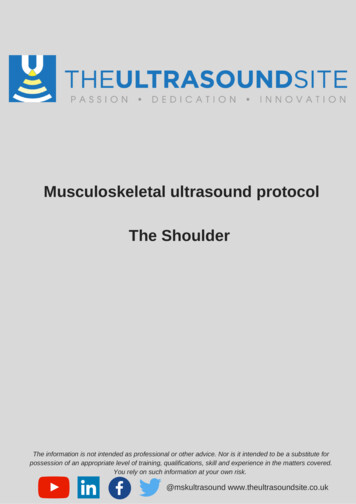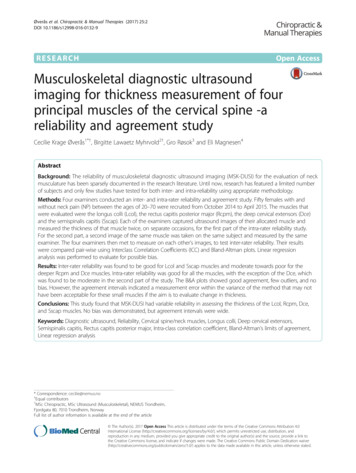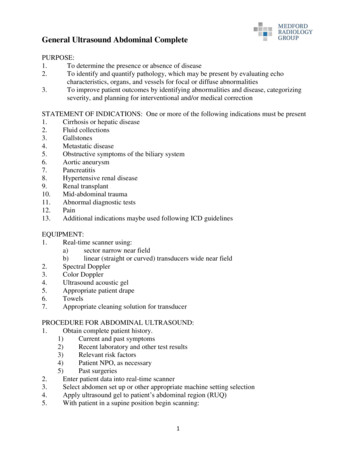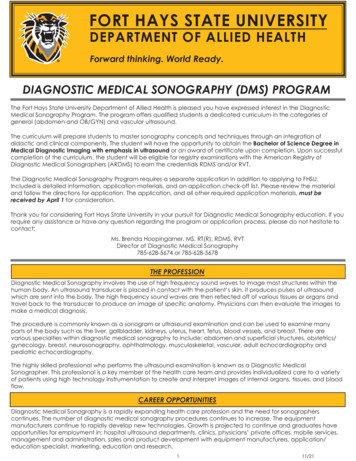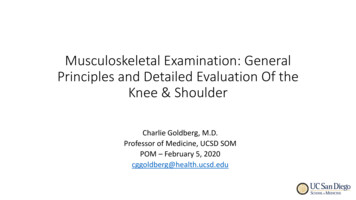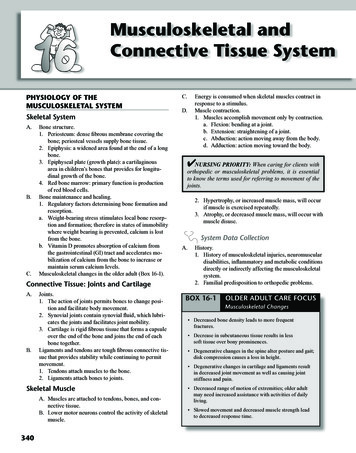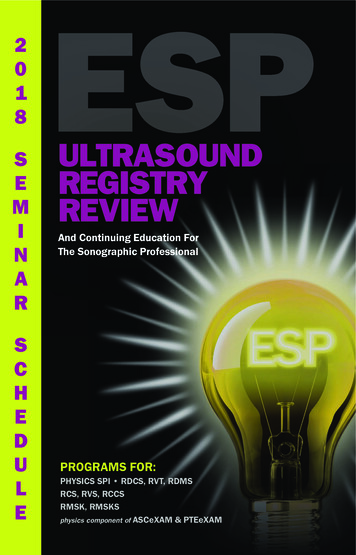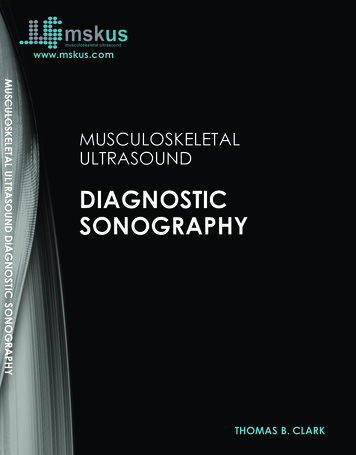
Transcription
European Society ofMusculoSkeletal RadiologyMusculoskeletal UltrasoundTechnical GuidelinesI. ShoulderIan Beggs, UKStefano Bianchi, SwitzerlandAngel Bueno, SpainMichel Cohen, FranceMichel Court-Payen, DenmarkAndrew Grainger, UKFranz Kainberger, AustriaAndrea Klauser, AustriaCarlo Martinoli, ItalyEugene McNally, UKPhilip J. O’Connor, UKPhilippe Peetrons, BelgiumMonique Reijnierse, The NetherlandsPhilipp Remplik, GermanyEnzo Silvestri, Italy
Shoulder1Although patient’s positioning for shoulder US varies widely across different Countries andInstitutions reflecting multifaceted opinions and experiences of different examiners, westrongly recommend to examine the patient while seated on a revolving stool. This positionallows the examiner to reach the anterior, lateral and posterior aspects of the shoulderwith the probe by simply asking the patient to rotate on the chair.2Place the arm in slight internal rotation (directed towards the contralateral knee) with theelbow flexed 90 , palm up. Start by finding the long biceps tendon in between the greaterand lesser tuberosities – Use short and long (more limited utility) axis planes to examinethe biceps.SubSGTLTShift the probe up to examine the biceps in its intraarticular course and down to reach themyotendinous junction (level of the pectoralis major tendon).SubSSupraSSHLHHLegend: SubS, subscapularis tendon; SupraS, supraspinatus tendon; Arrow, long head of the biceps tendon;LT, lesser tuberosity; GT, greater tuberosity; SH, short head of the biceps; LH, long head of the biceps; H,humeral shaft; Arrowheads, pectoralis major tendon1
Shoulder3Rotate the arm externally fixing the elbow on the iliac crest to show the subscapularis tendon and its insertion on the lesser tuberosity (slight supination of the hand may be helpfulto neutralize the tendency to lift and abduct the elbow from the lateral chest wall).DelCoSubSLTThis tendon should be evaluated along its long- (transverse planes) and short- (sagittalplanes) axis during passive external and internal rotation with hanging arm. Sweep thetransducer up and down over the subscapularis until its full width is demonstrated.SubSLTLTLegend: Arrow, long head of the biceps tendon; dashed line, insertion of the subscapularis tendon; Co, coracoid; Del, deltoid muscle; LT, lesser tuberosity; SubS, subscapularis tendon; void arrowheads, tendon fasciclesof the subscapularis; white arrowheads, muscle tissue interposed between tendon fascicles2
Shoulder4Moving the probe toward medial on transverse planes, look at the coracoid process, thecoracoacromial ligament (the medial margin of the transducer is on the coracoid processand the lateral edge is shifted upward and laterally towards the acromion), the conjoinedtendon and the anterior aspect of the subacromial subdeltoid bursa. Then, check the subscapularis recess and the subcoracoid bursa for effusion. External and internal rotationmay also used to demonstrate anteromedial impingement (distance between coracoid process and lesser tuberosity measured in internal rotation).CoBrSubSCoAcrSupraSHHLegend: Acr, acromion; Arrows, short head of the biceps; Arrowheads, coracoacromial ligament; Co, coracoid;CoBr, coraco-brachialis; HH, humeral head; SubS, subscapularis tendon; SupraS, supraspinatus5Place the patient’s arm posteriorly, placing the palmar side of thehand on the superior aspect ofthe iliac wing with the elbow flexed and directed posteriorly. Thesupraspinatus tendon should beevaluated along its long- andshort-axis.3
Shoulder5Refer to the intraarticular portion ofthe biceps as a landmark to obtainproper transducer orientation forimaging the supraspinatus. In fact,these tendons run parallel one tothe other and the intraarticular portion of the biceps is easy to be recognized due to a more clearly defined fibrillar pattern. One should rotate the transducer until the bicepsis depicted as more elongated aspossible in the US image. Then, theprobe is shifted upward and posteriorly over the supraspinatus withoutchanging its orientation. The resulting image is in axis with the supraspinatus. Between the supraspinatus and the deltoid, the normal subacromial-subdeltoid bursa appearsas a thin hypoechoic band.DelAcr*DelSupraSSupraSGTTilt the transducer gently in the area overlying the tendon insertion to avoid anisotropy.Remember to scan the lateral pouch of the subacromial subdeltoid bursa along the lateraledge of the greater tuberosity. When looking for the supraspinatus on short-axis, the normal cuff must have almost the same thickness from the biceps tendon landmark until 2cmbackwards: from this point backwards the tendon seen is the infraspinatus.Legend: Acr, acromion; asterisk, myotendinous junction; Del, deltoid muscle; GT, greater tuberosity; voidarrow-head, articular cartilage; curved arrow, hypoechoic artifact related to anisotropy; straight arrow, longhead of the biceps tendon; SupraS, supraspinatus tendon; white arrowhead, subacromial subdeltoid bursa4
Shoulder6Place the dorsum of the hand over the opposite back pocket (forced internal rotation,stress manoeuvre). There should not be any space gap between the elbow and the lateral chest wall. Using this position, the supraspinatus becomes a more anterior structureand the transducer should be oriented almost vertically to be in axis with it. Consider thatthe tendon fibers are more stretched than in the position described at point -5. This maybe possible cause of overestimation of tear size. Due to an excessive internal rotation,the long head of the biceps tendon may be difficult to be visualized in this position.NeutralInternal Rotation7Dynamic assessment of subacromial (antero-superior) impingement can be attempted byplacing the probe in the coronal plane with its medial margin at the lateral margin of theacromion. The patient abducts his arm while in internal rotation. With this manoeuvre, thesupraspinatus and the bursa can be seen passing deep to the coracoacromial arch.AcrGTAcrGTLegend: Acr, acromion; GT, greater tuberosity; arrows, supraspinatus tendon5
Shoulder8Place the transducer over the posterior aspect of the glenohumeral joint with the arm inthe same position described at point-2 (or with the hand on the opposite shoulder) andincrease the depth to include the structures of the posterior fossa within the field-of-viewof the US image. Use the spine of the scapula as the landmark to distinguish thesupraspinous fossa (transducer shifted-up) from the infraspinous fossa (transducershifted-down) on sagittal planes.12Legend: a, supraspinatus; arrow, spine of the scapula; b, infraspinatus; c, teresminor; dashed line, spine of the scapula; 1, supraspinous fossa; 2, infraspinousfossa; void arrowheads, deltoid; white arrowheads, trapeziusLook at the infraspinatus and teres minor muscles as individual structures filling the infraspinous fossa deep to the deltoid. After scanning these muscles, sweep the transducer toward the greater tuberosity on sagittal planes. The two tendons can be appreciatedas individual structures arising from the respective muscles.*DelInfraS*TmDelGTLegend: asterisk, spine of the scapula; dashed line, spine of the scapula; Del, deltoid muscle; GT, greater tuberosity; InfraS, infraspinatus muscle; Tm, teres minor muscle; void arrow, teres minor tendon; white arrows,infraspinatus tendon6
Shoulder9Examine these tendons separately on their long-axis (transverse planes) during externaland internal rotation of the arm (same position as in point-2) by placing the probe overthe posterior aspect of the glenohumeral joint.HHLook at the posterior labrum-capsular complex and check the posterior recess of thejoint for effusion during scanning. In thinsubjects the posterior labrum can be clearly seen. Move the transducer medial to thelabrum on transverse plane to visualize thespinoglenoid notch. It is often necessary toincrease the depth of the field-of-view notto miss this area. A paralabral cyst originating in this area should be sought.HHInfraSHH*Legend: asterisk, spinoglenoid notch; curved arrow, bony glenoid; HH, humeral head; InfraS, infraspinatus; voidarrows, teres minor tendon; white arrows, infraspinatus tendon; white arrowheads, posterior labrum10Place the transducer in the coronal planeover the shoulder to examine theacromioclavicular joint. Sweep the transducer anteriorly and posteriorly over thisjoint to assess the presence of an osacromiale. Shifting the probe posterior tothe acromioclavicular joint, it is possibleto assess the status of the supraspinatusmuscle.Cl*AcrLegend: Acr, acromion; arrowheads, superioracromioclavicular ligament; asterisk, acromioclavicular joint space; Cl, clavicle7
Musculoskeletal Ultrasound Technical Guidelines I.Shoulder Ian Beggs, UK Stefano Bianchi, Switzerland Angel Bueno, Spain Michel Cohen, France Michel Court-Payen, Denmark Andrew Grainger, UK Franz Kainberger, Austria Andrea Klauser, Austria Carlo Martinoli, Italy Eugene McNally, UK Philip J. O’Connor, UK Philippe Peetrons, BelgiumFile Size: 2MBPage Count: 8Explore further[PDF] Musculoskeletal ultrasound: technical guidelines .www.semanticscholar.orgUltrasound - European Society of Musculoskeletal Radiologywww.essr.orgThe Shoulder Musculoskeletal ultrasound protocolbohnf3ia6ymaonb53d05aq19- International Standards for Neurological Classification of .asia-spinalinjury.orgMRI of the Thumb: Anatomy and Spectrum of Findings in .www.ajronline.orgRecommended to you b


